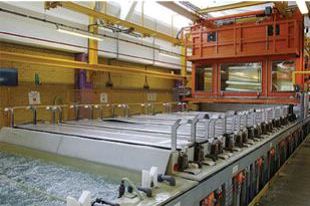Anodizing


GALCO’s surface treatment division is capable on handling of 75 MT / Month, Natural & SnSo4 based colour Anodizing with precision and Aesthetic match delivered with permanent sealing ( hot & cold ) from 5 to 25 Micron
Anodising can substantially increase corrosion resistance and wear resistance, and anodised parts provide better adhesion for paint primers and glues than bare metal. GALCO Aluminium Components has the capacity to anodise components produced from aluminium extrusions and ranging from 10 mm to 2.7 metres in shades of gold, silver, natural and black.
Anodising can be performed on parts you supply or as one of the added processes applied to aluminium extrusions and components we manufacture for you.
What Is Anodising or Anodizing?
Anodising is an electrolytic passivation process used to increase the thickness of the natural oxide layer on the surface of metal parts. The process is called anodising because the part to be treated forms the anode electrode of an electrical circuit. Anodising increases corrosion resistance and wear resistance, and provides better adhesion for paint primers and glues than bare metal. Anodic films can also be used for a number of cosmetic effects, either with thick porous coatings that can absorb dyes or with thin transparent coatings that add interference effects to reflected light. Anodising is also used to prevent galling of threaded components and to make dielectric films for electrolytic capacitors. Anodic films are most commonly applied to protect aluminium alloys, although processes also exist for titanium, zinc, magnesium, niobium, and tantalum. This process is not a useful treatment for iron or carbon steel because these metals exfoliate when oxidised; i.e. the iron oxide (also known as rust) flakes off, constantly exposing the underlying metal to corrosion.
Choosing the right Aluminium alloy for an anodizing job can be a difficult process. There are many types of Aluminium alloy available and most come in various tempers. Alloys are divided into groups each with certain physical characteristics and properties that may or may no suit your needs. In addition each of these alloys will anodise differently and this will need to be taken into account when selecting your Aluminium alloy.
If you are intending on making a product out of Aluminium that you intend to anodise, then in addition to the physical characte ristics of the Alloy it is important that consderation is taken of the following;
» Is the main purpose of the anodising protective, decorative or both?
» Do you require a matt or bright finish?
» Do you require a natural or coloured finish?
» Do you require hard anodising?
» The answers to these question should help you determine the most suitable alloy to use.




